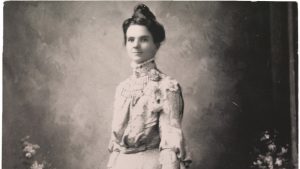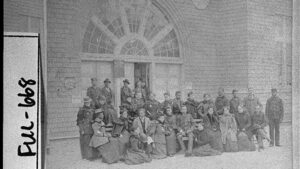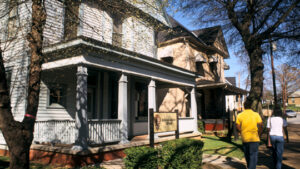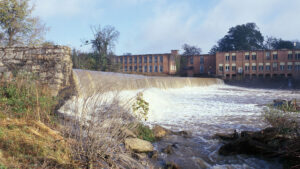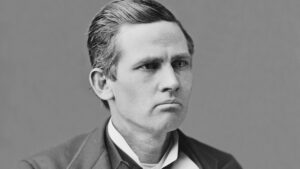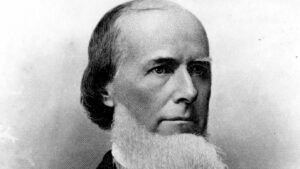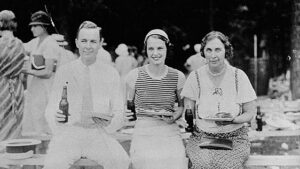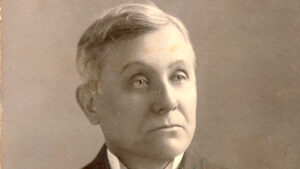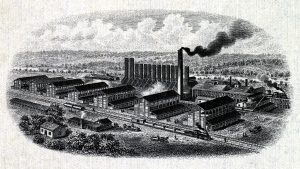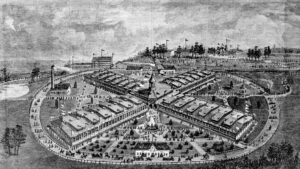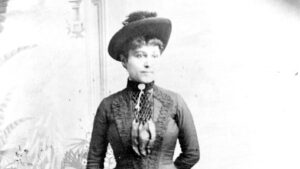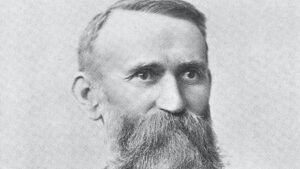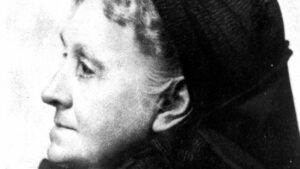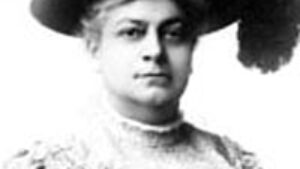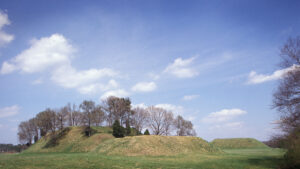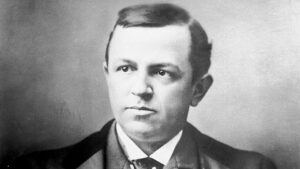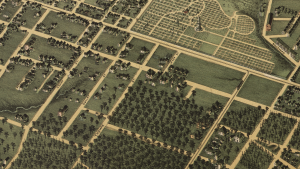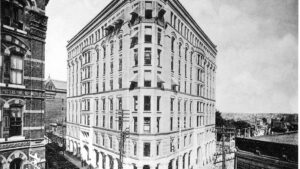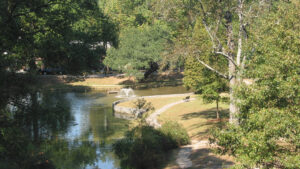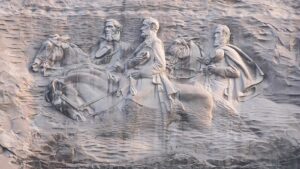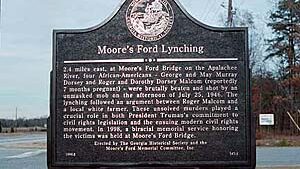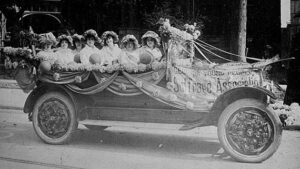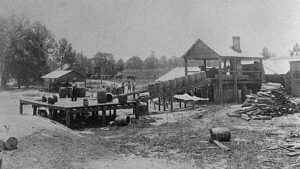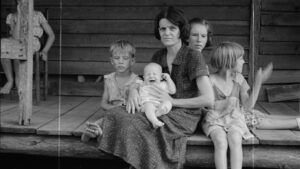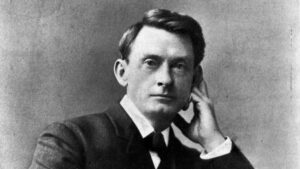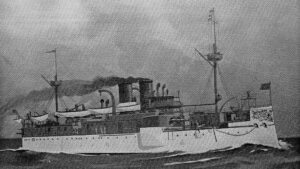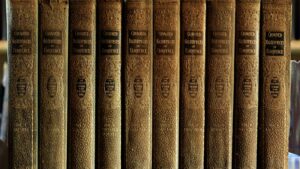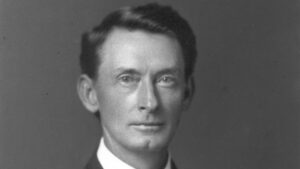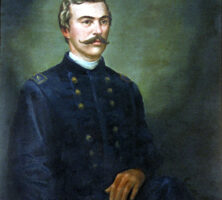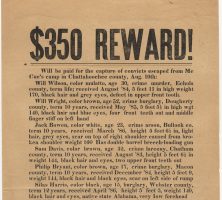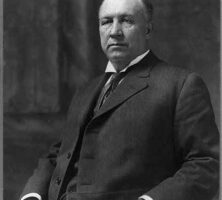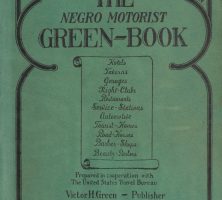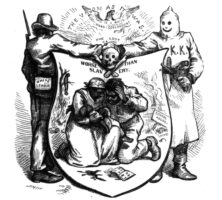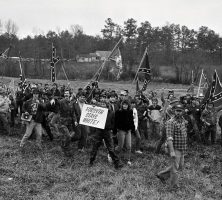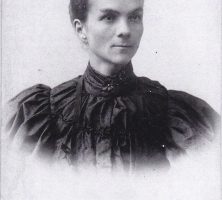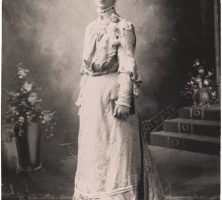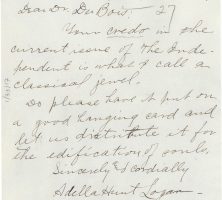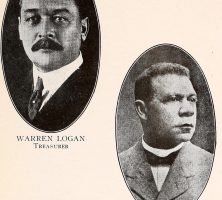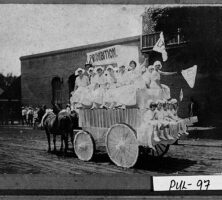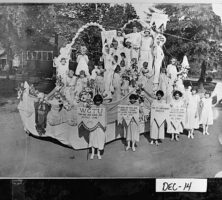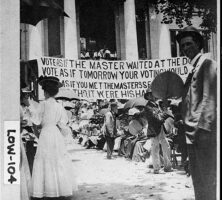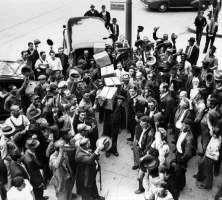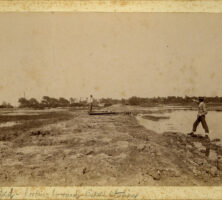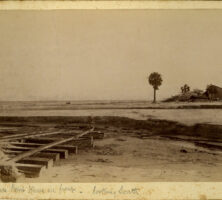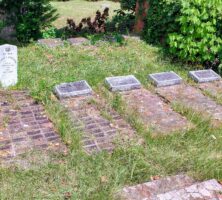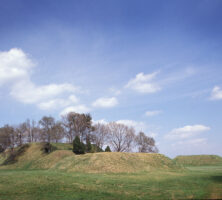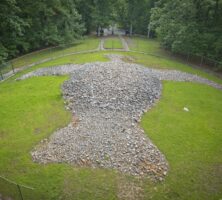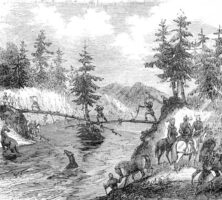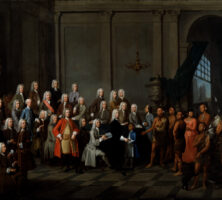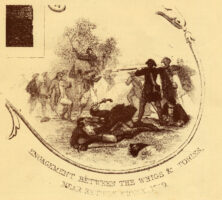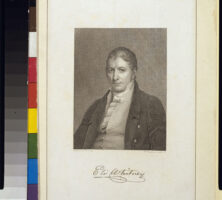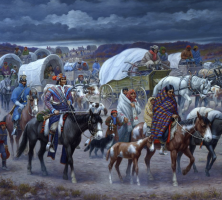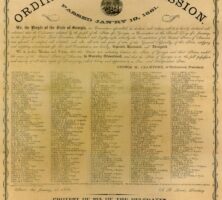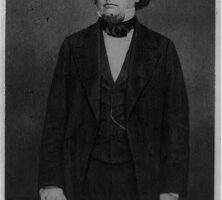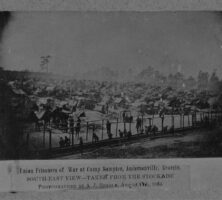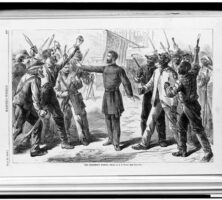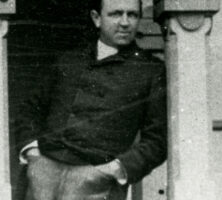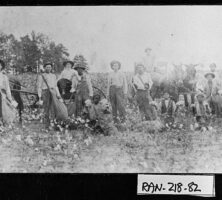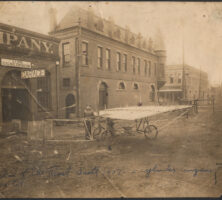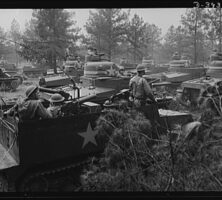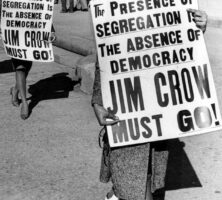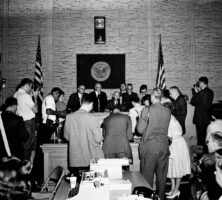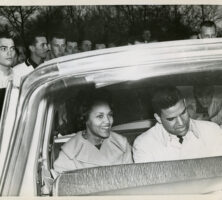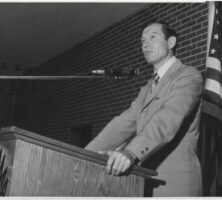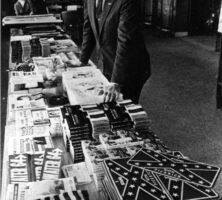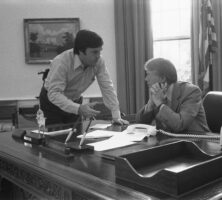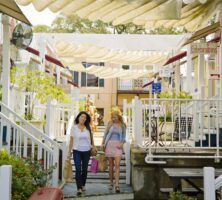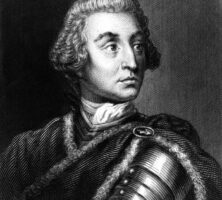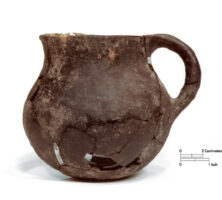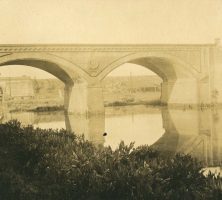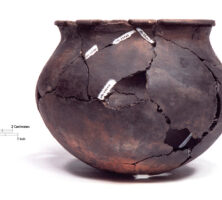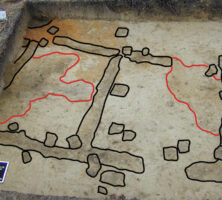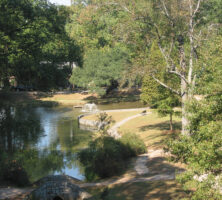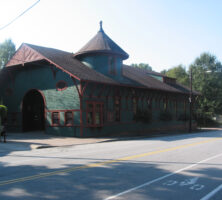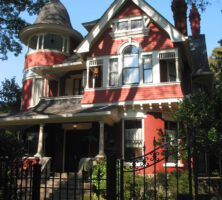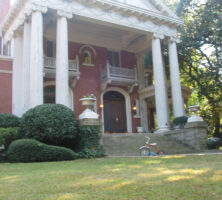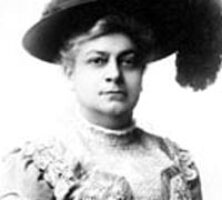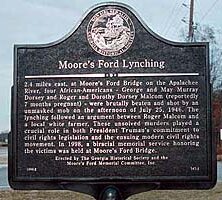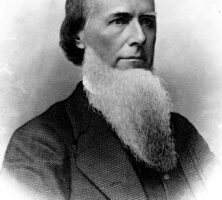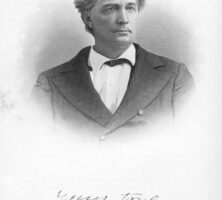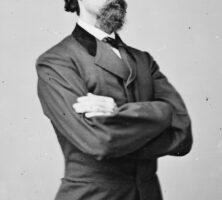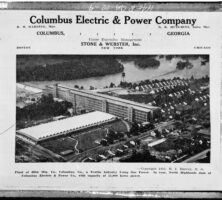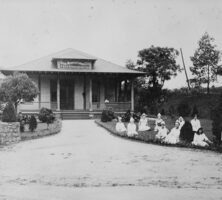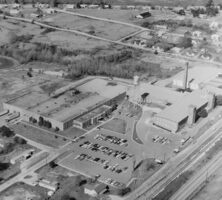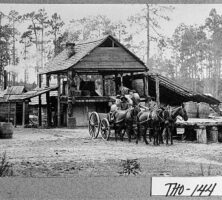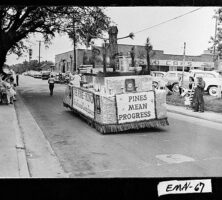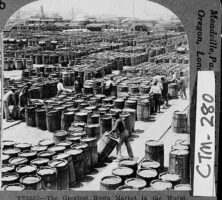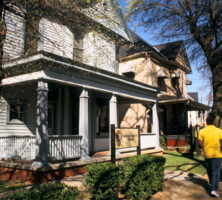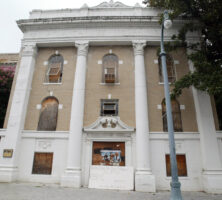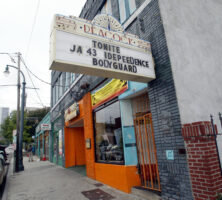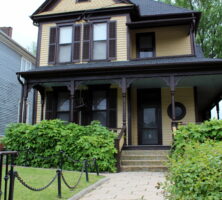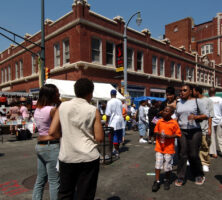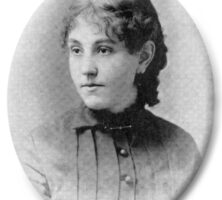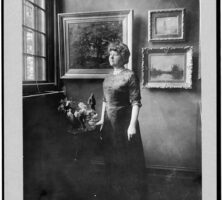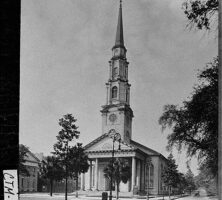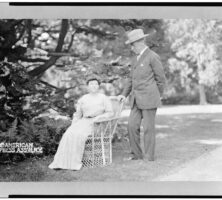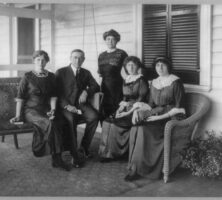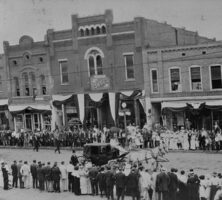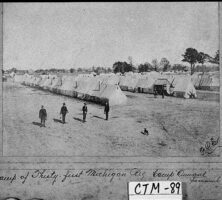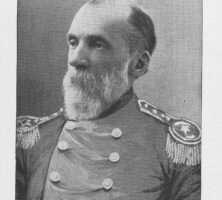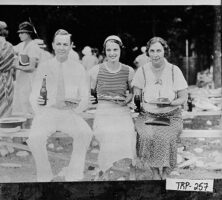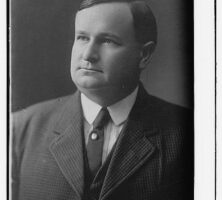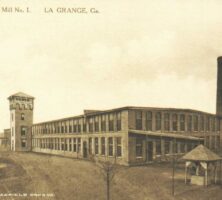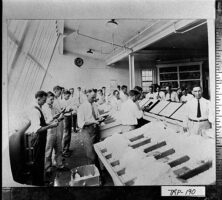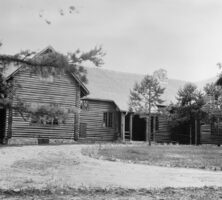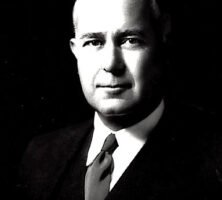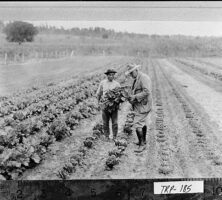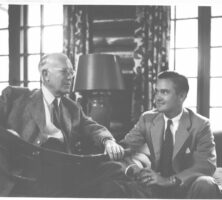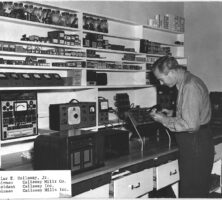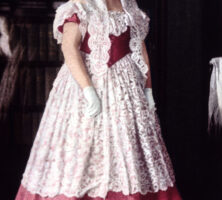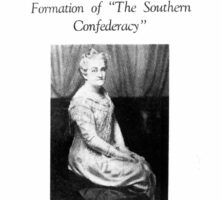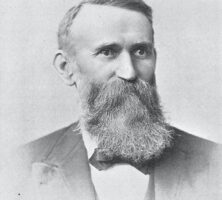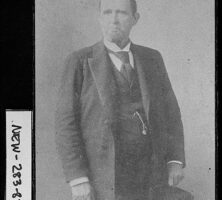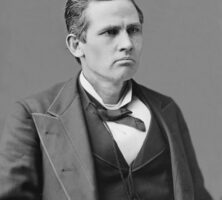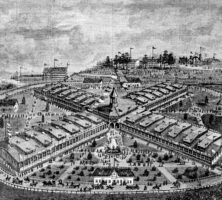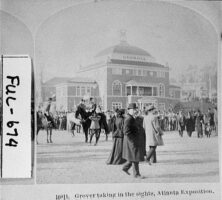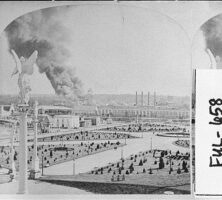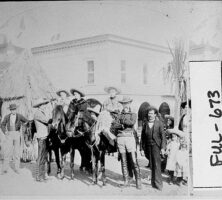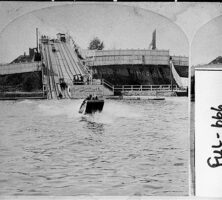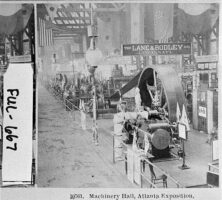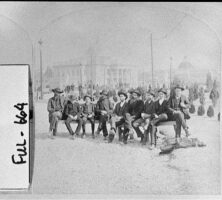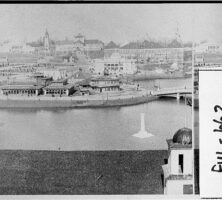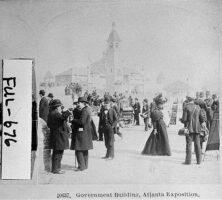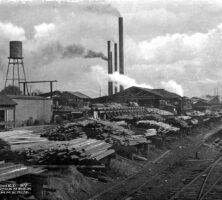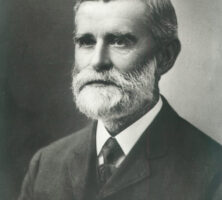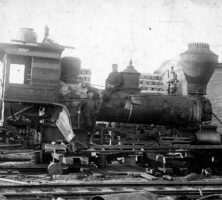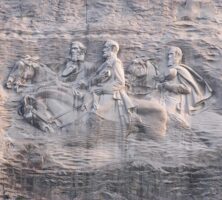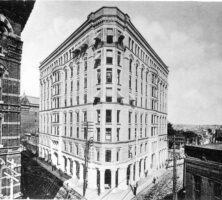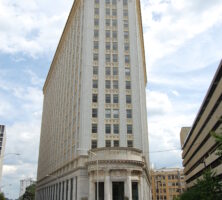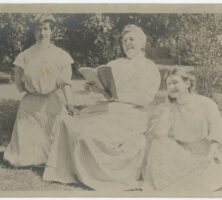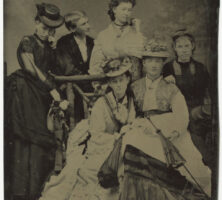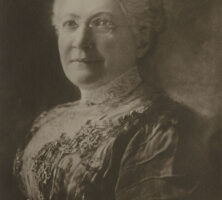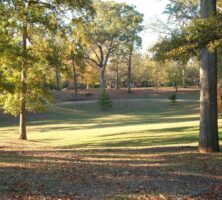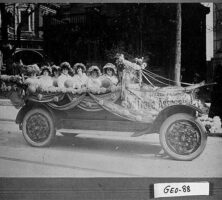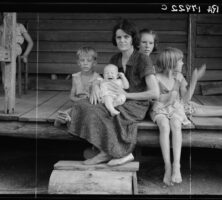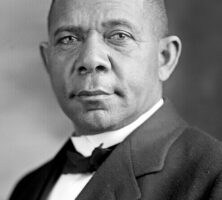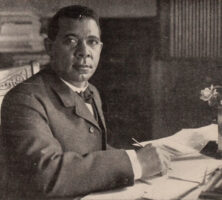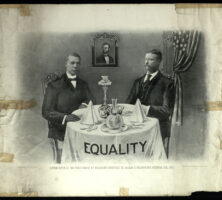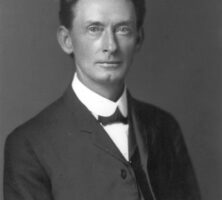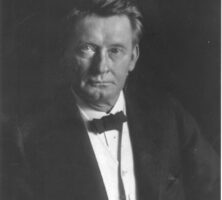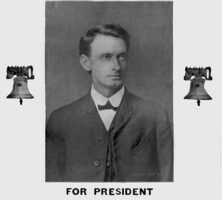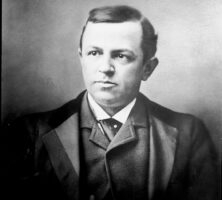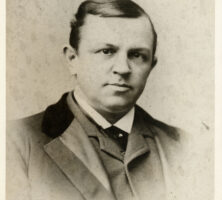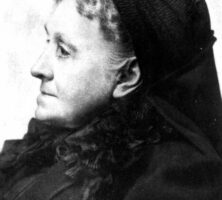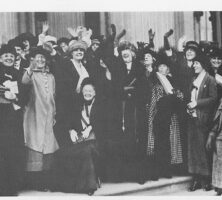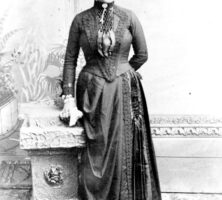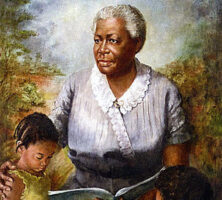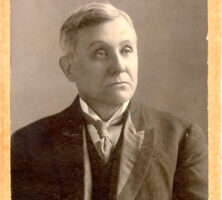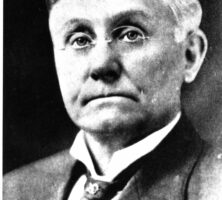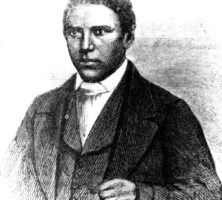The New Georgia Encyclopedia is supported by funding from A More Perfect Union, a special initiative of the National Endowment for the Humanities.
The Chattahoochee Brick Company was among the largest and most notorious employers of convict labor in Georgia. Under the terms of the convict lease system, Chattahoochee Brick forced thousands of Black Georgians to labor under conditions that have been described as industrial slavery.
Courtesy of Atlanta History Center.
The New Georgia Encyclopedia does not hold the copyright for this media resource and can neither grant nor deny permission to republish or reproduce the image online or in print. Requests for permission to publish or reproduce the resource should be submitted to the Atlanta History Center.
Thomas Ruger, a Union officer, was appointed military provisional governor of Georgia in 1868, during Reconstruction. During his six-month tenure, Ruger instituted the state's convict lease system.
Courtesy of Georgia Capitol Museum, University of Georgia Libraries
The New Georgia Encyclopedia does not hold the copyright for this media resource and can neither grant nor deny permission to republish or reproduce the image online or in print. All requests for permission to publish or reproduce the resource must be submitted to the rights holder.
A $350 reward was issued for escaped convict laborers from the Chattahoochee Brick Company.
Courtesy of Hargrett Rare Book and Manuscript Library, University of Georgia Libraries, Historical Broadsides Collection.
The New Georgia Encyclopedia does not hold the copyright for this media resource and can neither grant nor deny permission to republish or reproduce the image online or in print. Requests for permission to publish or reproduce the resource should be submitted to the Hargrett Manuscript and Rare Book Library at the University of Georgia.
Hoke Smith poses for a portrait in 1912, the year after his second term as Georgia's governor had ended. Smith served as governor first from 1907 to 1909 and then again in 1911, until he was selected to fill the empty U.S. Senate seat of Joseph M. Terrell. He remained in this seat until 1921.
Courtesy of Library of Congress, Prints and Photographs Division
The New Georgia Encyclopedia does not hold the copyright for this media resource and can neither grant nor deny permission to republish or reproduce the image online or in print. All requests for permission to publish or reproduce the resource must be submitted to the rights holder.
Formed as the result of several mergers, First National Bank of Atlanta (or First Atlanta) was the largest U.S. bank south of Philadelphia in 1929. The First National Bank Building served as First Atlanta's headquarters.
Courtesy of Wachovia Corporation
The New Georgia Encyclopedia does not hold the copyright for this media resource and can neither grant nor deny permission to republish or reproduce the image online or in print. All requests for permission to publish or reproduce the resource must be submitted to the rights holder.
The Negro Motorist Green-Book, also known as the Negro Traveller's Green-Book, was an essential guide for Black travelers between 1936 and 1966. This yearly publication, created by postal employee Victor Hugo Green, helped readers avoid sundown towns and locate safe lodging, gas stops, and eateries.
From Wikimedia
The New Georgia Encyclopedia does not hold the copyright for this media resource and can neither grant nor deny permission to republish or reproduce the image online or in print. All requests for permission to publish or reproduce the resource must be submitted to the rights holder.
Most Ku Klux Klan action was designed to intimidate Black voters and white supporters of the Republican Party. Founded in Tennessee in 1866, the Klan was particularly active in Georgia from 1868 to the early 1870s.
From Harper's Weekly
The New Georgia Encyclopedia does not hold the copyright for this media resource and can neither grant nor deny permission to republish or reproduce the image online or in print. All requests for permission to publish or reproduce the resource must be submitted to the rights holder.
White supremacists picketing at the first Brotherhood March on January 17, 1987, in Forsyth County.
Courtesy of Atlanta Journal-Constitution, Atlanta Journal-Constitution Photographic Archive, #AJCNS1987-01-17l.
The New Georgia Encyclopedia does not hold the copyright for this media resource and can neither grant nor deny permission to republish or reproduce the image online or in print. All requests for permission to publish or reproduce the resource must be submitted to the Atlanta Journal-Constitution.
Educator and suffragist Adella Hunt Logan received an honorary master's degree from Atlanta University in 1901. The degree was "honorary" because the school was not yet accredited to grant graduate degrees.
From Adele Logan Alexander's personal collection
The New Georgia Encyclopedia does not hold the copyright for this media resource and can neither grant nor deny permission to republish or reproduce the image online or in print. All requests for permission to publish or reproduce the resource must be submitted to the rights holder.
Adella Hunt Logan is pictured in her wedding dress in Atlanta. She married Tuskegee Institute treasurer Warren Logan in 1888.
From Wikimedia
The New Georgia Encyclopedia does not hold the copyright for this media resource and can neither grant nor deny permission to republish or reproduce the image online or in print. All requests for permission to publish or reproduce the resource must be submitted to the rights holder.
After accepting a teaching position at the Tuskegee Institute in 1883, Adella Hunt Logan forged enduring relationships with fellow educators and civil rights leaders. Among her new acquaintances was NAACP cofounder W. E. B. Du Bois, with whom she shared a lifelong correspondence.
Courtesy of Special Collections and University Archives, University of Massachusetts Amherst Libraries
The New Georgia Encyclopedia does not hold the copyright for this media resource and can neither grant nor deny permission to republish or reproduce the image online or in print. All requests for permission to publish or reproduce the resource must be submitted to the rights holder.
Tuskegee Institute founder Booker T. Washington and school treasurer Warren Logan are featured in the Lincoln Jubilee Album, shortly after Washington's death in 1915.
Image from Wikimedia, Lincoln Financial Foundation Collection.
The New Georgia Encyclopedia does not hold the copyright for this media resource and can neither grant nor deny permission to republish or reproduce the image online or in print. All requests for permission to publish or reproduce the resource must be submitted to the rights holder.
Young women and children ride on a parade float promoting prohibition in Hawkinsville (Pulaski County), circa 1919.
Courtesy of Georgia Archives, Vanishing Georgia, #
pul097a.
The New Georgia Encyclopedia does not hold the copyright for this media resource and can neither grant nor deny permission to republish or reproduce the image online or in print. Requests for permission to publish or reproduce the resource should be submitted to the Georgia Archives.
Women's Christian Temperance Movement (WTCU) members participate in the Decatur County centennial parade in Bainbridge, 1923. The WCTU formed its first Georgia chapter in 1880. Largely due to their efforts, Georgia passed a local option law in 1885.
Courtesy of Georgia Archives, Vanishing Georgia, #
dec014.
The New Georgia Encyclopedia does not hold the copyright for this media resource and can neither grant nor deny permission to republish or reproduce the image online or in print. Requests for permission to publish or reproduce the resource should be submitted to the Georgia Archives.
A crowd gathered in front of the Lowndes County courthouse in Valdosta for a prohibition vote in 1907. That year, Georgia became the first state in the South to pass a statewide ban on the production, transportation, and sale of alcohol.
Courtesy of Georgia Archives, Vanishing Georgia, #
low104.
The New Georgia Encyclopedia does not hold the copyright for this media resource and can neither grant nor deny permission to republish or reproduce the image online or in print. Requests for permission to publish or reproduce the resource should be submitted to the Georgia Archives.
A crowd in Marietta celebrates the end of prohibition. In 1935 the Georgia legislature approved the Alcoholic Beverage Control Act, which called for a statewide referendum on the issue of repeal and tasked the State Revenue Commission with drafting new regulations to govern the sale and distribution of alcohol.
Courtesy of Special Collections & Archives, Georgia State University Library, Atlanta Journal-Constitution Photographic Archive.
The New Georgia Encyclopedia does not hold the copyright for this media resource and can neither grant nor deny permission to republish or reproduce the image online or in print. Requests for permission to publish or reproduce the resource should be submitted to Special Collections and Archives at Georgia State University.
Damaged homes along the beach after the 1893 hurricane hit Tybee. One of the deadliest hurricanes in American history, the storm was the equivalent of a Category 3 hurricane on the modern-day Saffir-Simpson scale.
Courtesy of Georgia Historical Society, Elizabeth B. Pittman Collection on Nichols, Baker, and Mongin Families., #GHS 2536-01-07-11.
The New Georgia Encyclopedia does not hold the copyright for this media resource and can neither grant nor deny permission to republish or reproduce the image online or in print. All requests for permission to publish or reproduce the resource must be submitted to Georgia Historical Society.
Men along a flooded road after the 1893 hurricane hit Tybee. The storm devastated the barrier islands of Georgia and South Carolina, killing over 2,000 people and leaving more than 30,000 homeless.
Courtesy of Georgia Historical Society, Elizabeth B. Pittman Collection on Nichols, Baker, and Mongin Families., #GHS 2536-01-07-03.
The New Georgia Encyclopedia does not hold the copyright for this media resource and can neither grant nor deny permission to republish or reproduce the image online or in print. All requests for permission to publish or reproduce the resource must be submitted to Georgia Historical Society.
Damaged railroad tracks and homes on the beach after 1893 hurricane hit Tybee. Buildings, bridges, and other infrastructure were demolished up and down the Georgia and South Carolina coasts.
Courtesy of Georgia Historical Society, Elizabeth B. Pittman Collection on Nichols, Baker, and Mongin Families., #GHS 2536-01-07-06.
The New Georgia Encyclopedia does not hold the copyright for this media resource and can neither grant nor deny permission to republish or reproduce the image online or in print. All requests for permission to publish or reproduce the resource must be submitted to Georgia Historical Society.
The New Georgia Encyclopedia does not hold the copyright for this media resource and can neither grant nor deny permission to republish or reproduce the image online or in print. All requests for permission to publish or reproduce the resource must be submitted to the rights holder.
Thomas G. Woolfolk was convicted and hanged for murdering nine members of his family in their Bibb County home on August 6, 1887. This drawing, adapted from a photograph taken of Woolfolk in the jail at Macon, appeared in the Oglethorpe Echo newspaper on November 7, 1890, about a week after his execution.
Drawing from Oglethorpe Echo
The New Georgia Encyclopedia does not hold the copyright for this media resource and can neither grant nor deny permission to republish or reproduce the image online or in print. All requests for permission to publish or reproduce the resource must be submitted to the rights holder.
Nine members of the Woolfolk family were murdered in their Bibb County home on August 6, 1887, by relative Thomas G. Woolfolk. The victims are buried together at Rose Hill Cemetery in Macon.
Photograph by amanderson2
The New Georgia Encyclopedia does not hold the copyright for this media resource and can neither grant nor deny permission to republish or reproduce the image online or in print. All requests for permission to publish or reproduce the resource must be submitted to the rights holder.
The New Georgia Encyclopedia does not hold the copyright for this media resource and can neither grant nor deny permission to republish or reproduce the image online or in print. All requests for permission to publish or reproduce the resource must be submitted to the rights holder.
The Etowah Mounds in Bartow County include one of the largest Indian mounds in North America. The mounds, constructed during the Mississippian Period, served as platforms for public buildings in a town that occupied the site from around 1100 until the 1600s.
The New Georgia Encyclopedia does not hold the copyright for this media resource and can neither grant nor deny permission to republish or reproduce the image online or in print. Requests for permission to publish or reproduce the resource may need to be submitted to the Georgia Department of Community Affairs, Historic Preservation Division.
Rock Eagle, a stone effigy built by Native Americans during the Woodland Period, circa A.D. 200, is located in Putnam County. The structure, made of quartz cobbles, measures 102 feet across the wings.
Courtesy of Explore Georgia, Photograph by Ralph Daniel.
The New Georgia Encyclopedia does not hold the copyright for this media resource and can neither grant nor deny permission to republish or reproduce the image online or in print. Requests for permission to publish or reproduce the resource may need to be submitted to Explore Georgia.
The New Georgia Encyclopedia does not hold the copyright for this media resource and can neither grant nor deny permission to republish or reproduce the image online or in print. All requests for permission to publish or reproduce the resource must be submitted to the rights holder.
A drawing from Lambert A. Wilmer's Life, Travels and Adventures of Ferdinand de Soto, Discoverer of the Mississippi (1859) depicts Hernando de Soto and his men crossing the Chattahoochee River. The accidental introduction of European diseases by explorers destroyed many of the civilizations along the river's banks.
Courtesy of Florida State Archives, Photographic Collection.
The New Georgia Encyclopedia does not hold the copyright for this media resource and can neither grant nor deny permission to republish or reproduce the image online or in print. All requests for permission to publish or reproduce the resource must be submitted to the rights holder.
This oil painting by William Verelst shows the founders of Georgia, the Georgia Trustees, and a delegation of Georgia Indians in July 1734. One year later the Trustees persuaded the British government to support a ban on slavery in Georgia.
Courtesy of Georgia Info, Digital Library of Georgia.
The New Georgia Encyclopedia does not hold the copyright for this media resource and can neither grant nor deny permission to republish or reproduce the image online or in print. Requests for permission to publish or reproduce the resource may need to be submitted to the Digital Library of Georgia.
The New Georgia Encyclopedia does not hold the copyright for this media resource and can neither grant nor deny permission to republish or reproduce the image online or in print. All requests for permission to publish or reproduce the resource must be submitted to the rights holder.
This sketch, likely a small portion of a larger work, depicts the Battle of Kettle Creek, which took place in Wilkes County on February 14, 1779, during the Revolutionary War. The original caption reads: "Engagement between the Whigs and Tories."
Courtesy of Kettle Creek Chapter of the National Society Daughters of the American Revolution
The New Georgia Encyclopedia does not hold the copyright for this media resource and can neither grant nor deny permission to republish or reproduce the image online or in print. All requests for permission to publish or reproduce the resource must be submitted to the rights holder.
The inventor of the cotton gin, Eli Whitney lived in Georgia for just a year, on Catharine Greene's Mulberry Grove plantation near Savannah. After learning of the difficulty planters had with separating seeds from fibers in upland, or "short-staple," cotton, he set out to create a machine that could perform such a task more efficiently. His invention, the cotton gin, revolutionized the southern economy.
Courtesy of Library of Congress, Prints and Photographs Division
The New Georgia Encyclopedia does not hold the copyright for this media resource and can neither grant nor deny permission to republish or reproduce the image online or in print. All requests for permission to publish or reproduce the resource must be submitted to the rights holder.
The New Georgia Encyclopedia does not hold the copyright for this media resource and can neither grant nor deny permission to republish or reproduce the image online or in print. All requests for permission to publish or reproduce the resource must be submitted to the rights holder.
In his 1942 painting Cherokee Trail of Tears, Robert Lindneux depicts the forced journey of the Cherokees in 1838 to present-day Oklahoma.
Courtesy of Woolaroc Museum, Bartlesville, Oklahoma
The New Georgia Encyclopedia does not hold the copyright for this media resource and can neither grant nor deny permission to republish or reproduce the image online or in print. All requests for permission to publish or reproduce the resource must be submitted to the rights holder.
On January 21, 1861, the ordinance of secession was publicly signed in a ceremony by Georgia politicians. Two days earlier, delegates to a convention in Milledgeville voted 208 to 89 for the state to secede from the Union.
The New Georgia Encyclopedia does not hold the copyright for this media resource and can neither grant nor deny permission to republish or reproduce the image online or in print. Requests for permission to publish or reproduce the resource should be submitted to the Hargrett Manuscript and Rare Book Library at the University of Georgia.
Wilkes County native Robert Toombs, pictured circa 1865, served briefly as the Confederate government's secretary of state and as a brigadier general during the Civil War.
Courtesy of Library of Congress, Prints and Photographs Division
The New Georgia Encyclopedia does not hold the copyright for this media resource and can neither grant nor deny permission to republish or reproduce the image online or in print. All requests for permission to publish or reproduce the resource must be submitted to the rights holder.
Union prisoners of war are pictured at the Andersonville Prison in Macon County on August 17, 1864. Malnutrition and poor sanitary conditions at the camp led to the deaths of nearly 13,000 of Andersonville's 45,000 prisoners, the highest mortality rate of any Civil War prison.
Courtesy of Civil War Treasures, New-York Historical Society
The New Georgia Encyclopedia does not hold the copyright for this media resource and can neither grant nor deny permission to republish or reproduce the image online or in print. All requests for permission to publish or reproduce the resource must be submitted to the rights holder.
An 1868 sketch by A. R. Waud illustrates the difficulties faced by the Freedmen's Bureau, caught between white planters on one side (left) and formerly enslaved African Americans on the other (right). The bureau was established in 1865 after Union general William T. Sherman issued his Field Order No. 15, which called for the resettlement of freedpeople on confiscated lands.
Courtesy of Library of Congress, Prints and Photographs Division
The New Georgia Encyclopedia does not hold the copyright for this media resource and can neither grant nor deny permission to republish or reproduce the image online or in print. All requests for permission to publish or reproduce the resource must be submitted to the rights holder.
With his New South platform, Henry W. Grady advocated unity and trust between the North and South and helped to spur northern investment in Atlanta industries.
Courtesy of Stuart A. Rose Manuscript, Archives, and Rare Book Library, Emory University, Henry Woodfin Grady Papers.
The New Georgia Encyclopedia does not hold the copyright for this media resource and can neither grant nor deny permission to republish or reproduce the image online or in print. For more information about this resource, contact the Stuart A. Rose Manuscript, Archives, and Rare Book Library at Emory University.
Sharecroppers, pictured in 1910, harvest cotton in Randolph County. Theoretically beneficial to both laborers and landowners, the sharecropping system typically left workers in deep debt to their landlords and creditors from one harvest season to the next.
Courtesy of Georgia Archives, Vanishing Georgia, #ran218-82.
The New Georgia Encyclopedia does not hold the copyright for this media resource and can neither grant nor deny permission to republish or reproduce the image online or in print. Requests for permission to publish or reproduce the resource should be submitted to the Georgia Archives.
In 1892 Georgia politics was shaken by the arrival of the Populist Party. Led by Thomas E. Watson of McDuffie County, this new party mainly appealed to white farmers, many of whom had been impoverished by debt and low cotton prices in the 1880s and 1890s. The Populists also attempted to win the support of Black farmers away from the Republican Party.
Courtesy of Georgia Historical Society.
The New Georgia Encyclopedia does not hold the copyright for this media resource and can neither grant nor deny permission to republish or reproduce the image online or in print. All requests for permission to publish or reproduce the resource must be submitted to Georgia Historical Society.
The New Georgia Encyclopedia does not hold the copyright for this media resource and can neither grant nor deny permission to republish or reproduce the image online or in print. All requests for permission to publish or reproduce the resource must be submitted to the rights holder.
The New Georgia Encyclopedia does not hold the copyright for this media resource and can neither grant nor deny permission to republish or reproduce the image online or in print. All requests for permission to publish or reproduce the resource must be submitted to the rights holder.
U.S. president Franklin D. Roosevelt and his wife, Eleanor Roosevelt, visit Atlanta in 1935, during the Great Depression. From left: Franklin D. and Eleanor Roosevelt, U.S. senator Walter F. George, and U.S. senator Richard B. Russell Jr.
The New Georgia Encyclopedia does not hold the copyright for this media resource and can neither grant nor deny permission to republish or reproduce the image online or in print. Requests for permission to publish or reproduce the resource may need to be submitted to the Richard B. Russell Library for Political Research and Studies at the University of Georgia.
Georgia aviation pioneer Ben Epps is pictured with his first airplane outside his garage in Athens, 1907.
Courtesy of Georgia Archives, Vanishing Georgia, #
clr176-83.
The New Georgia Encyclopedia does not hold the copyright for this media resource and can neither grant nor deny permission to republish or reproduce the image online or in print. Requests for permission to publish or reproduce the resource should be submitted to the Georgia Archives.
U.S. soldiers, pictured in the spring of 1942, undergo training at Fort Benning in Columbus. During World War II Fort Benning was the largest infantry training post in the world.
Courtesy of Library of Congress, Prints and Photographs Division
The New Georgia Encyclopedia does not hold the copyright for this media resource and can neither grant nor deny permission to republish or reproduce the image online or in print. All requests for permission to publish or reproduce the resource must be submitted to the rights holder.
Students protest segregation at the state capitol building in Atlanta on February 1, 1962. The passage of the federal Civil Rights Act in 1964 and the Voting Rights Act in 1965 ended legal segregation across the nation.
Courtesy of Atlanta Journal-Constitution.
The New Georgia Encyclopedia does not hold the copyright for this media resource and can neither grant nor deny permission to republish or reproduce the image online or in print. All requests for permission to publish or reproduce the resource must be submitted to the Atlanta Journal-Constitution.
Reporters gather at Atlanta's city hall on August 30, 1961, the day that the city's schools were officially integrated. The recommendations of the Sibley Commission to the state legislature in 1960 contributed to the desegregation of schools across Georgia.
Courtesy of Special Collections & Archives, Georgia State University Library, Lane Brothers Commercial Photographers Photographic Collection.
The New Georgia Encyclopedia does not hold the copyright for this media resource and can neither grant nor deny permission to republish or reproduce the image online or in print. Requests for permission to publish or reproduce the resource should be submitted to Special Collections and Archives at Georgia State University.
Charlayne Hunter and Hamilton Holmes, the first Black students to enroll at the University of Georgia, are pictured here at the end of their first day on campus in January 1961.
Courtesy of Atlanta Journal-Constitution.
The New Georgia Encyclopedia does not hold the copyright for this media resource and can neither grant nor deny permission to republish or reproduce the image online or in print. All requests for permission to publish or reproduce the resource must be submitted to the Atlanta Journal-Constitution.
Martin Luther King Jr. (second from right) and Ralph David Abernathy (third from right) pray during their arrest in Albany on July 27, 1962. William G. Anderson, the president of the Albany Movement, asked King and Abernathy to help with efforts to desegregate the city.
The New Georgia Encyclopedia does not hold the copyright for this media resource and can neither grant nor deny permission to republish or reproduce the image online or in print. All requests for permission to publish or reproduce the resource must be submitted to the Walter J. Brown Media Archives and Peabody Awards Collection.
Augusta native Carl Sanders, elected governor of Georgia in 1962, brought the state into compliance with federal civil rights law during his single term in office.
The New Georgia Encyclopedia does not hold the copyright for this media resource and can neither grant nor deny permission to republish or reproduce the image online or in print. Requests for permission to publish or reproduce the resource should be submitted to the Hargrett Manuscript and Rare Book Library at the University of Georgia.
In 1966 Lester Maddox defeated former governor Ellis Arnall in the Democratic gubernatorial primary in a major political upset. Subsequently, as a result of a close race between Maddox and Republican Bo Callaway, the General Assembly chose Maddox as governor.
The New Georgia Encyclopedia does not hold the copyright for this media resource and can neither grant nor deny permission to republish or reproduce the image online or in print. Requests for permission to publish or reproduce the resource may need to be submitted to the Richard B. Russell Library for Political Research and Studies at the University of Georgia.
U.S. president Jimmy Carter (right) meets with Hamilton Jordan in the Oval Office of the White House in 1977. Jordan served as Carter's chief of staff from 1977 to 1980.
Courtesy of Jimmy Carter Presidential Library and Museum.
The New Georgia Encyclopedia does not hold the copyright for this media resource and can neither grant nor deny permission to republish or reproduce the image online or in print. Requests for permission to publish or reproduce the resource may need to be submitted to the Jimmy Carter Presidential Library and Museum.
The New Georgia Encyclopedia does not hold the copyright for this media resource and can neither grant nor deny permission to republish or reproduce the image online or in print. All requests for permission to publish or reproduce the resource must be submitted to the rights holder.
Georgia farmers lead the United States in peanut production, raising approximately 45 percent of the nation's total harvest. Grown in most south Georgia counties, peanuts are the official state crop.
Courtesy of Explore Georgia, Photograph by Ralph Daniel.
The New Georgia Encyclopedia does not hold the copyright for this media resource and can neither grant nor deny permission to republish or reproduce the image online or in print. Requests for permission to publish or reproduce the resource may need to be submitted to Explore Georgia.
The New Georgia Encyclopedia does not hold the copyright for this media resource and can neither grant nor deny permission to republish or reproduce the image online or in print. All requests for permission to publish or reproduce the resource must be submitted to the rights holder.
Latino workers plant loblolly pine seedlings in 1999 near Bremen, in Haralson County. Latino immigrants came to Georgia in large numbers during the 1980s and 1990s to work in the agriculture, construction, carpet, and poultry processing industries.
Courtesy of Atlanta Journal-Constitution.
The New Georgia Encyclopedia does not hold the copyright for this media resource and can neither grant nor deny permission to republish or reproduce the image online or in print. All requests for permission to publish or reproduce the resource must be submitted to the Atlanta Journal-Constitution.
Tourists on St. Simons Island gather outside one of the island's many shops. The island suffered an economic depression at the end of the cotton era in the 1830s, but its fortunes reversed with the arrival of the timber industry in the 1870s. Today St. Simons enjoys a strong tourist industry.
Courtesy of Explore Georgia.
The New Georgia Encyclopedia does not hold the copyright for this media resource and can neither grant nor deny permission to republish or reproduce the image online or in print. Requests for permission to publish or reproduce the resource may need to be submitted to Explore Georgia.
James Oglethorpe, a leader in the British movement to found a new colony in America, set sail for the new world on November 17, 1732, accompanied by Georgia's first settlers.
The New Georgia Encyclopedia does not hold the copyright for this media resource and can neither grant nor deny permission to republish or reproduce the image online or in print. Requests for permission to publish or reproduce the resource should be submitted to the Hargrett Manuscript and Rare Book Library at the University of Georgia.
Unrestored shotgun houses line a street in Macon. The shotgun, a rectangular house type that is one room wide and two to four rooms deep, may have developed from a West African architectural tradition.
Courtesy of Elizabeth Lyon
The New Georgia Encyclopedia does not hold the copyright for this media resource and can neither grant nor deny permission to republish or reproduce the image online or in print. All requests for permission to publish or reproduce the resource must be submitted to the rights holder.
Colonoware, a form of earthenware pottery, was made by African Americans on plantations in Georgia, North Carolina, and South Carolina. Produced circa 1740, this pitcher was found during an exacavation in Charleston, South Carolina, during the late 1990s.
Courtesy of New South Associates
The New Georgia Encyclopedia does not hold the copyright for this media resource and can neither grant nor deny permission to republish or reproduce the image online or in print. All requests for permission to publish or reproduce the resource must be submitted to the rights holder.
The Savannah-Ogeechee Canal, pictured circa 1888, was completed by enslaved laborers in 1829.
Courtesy of Georgia Historical Society, James S. Silva family papers, #GHS 2126-VM01-04 pg072.
The New Georgia Encyclopedia does not hold the copyright for this media resource and can neither grant nor deny permission to republish or reproduce the image online or in print. All requests for permission to publish or reproduce the resource must be submitted to Georgia Historical Society.
Slave quarters, pictured in 1936, stand at Liberty Hall in Taliaferro County, the homeplace of Georgia governor Alexander Stephens. African American structures on Georgia plantations were generally rectangular in shape, as opposed to the square forms preferred by Europeans.
Courtesy of Library of Congress, Prints and Photographs Division, Historic American Buildings Survey.
The New Georgia Encyclopedia does not hold the copyright for this media resource and can neither grant nor deny permission to republish or reproduce the image online or in print. All requests for permission to publish or reproduce the resource must be submitted to the rights holder.
This colonoware jar, uncovered in South Carolina in the 1990s, dates to the mid-eighteenth century. Colonoware was made by African Americans on coastal plantations and has been found on several Georgia sites.
Courtesy of New South Associates
The New Georgia Encyclopedia does not hold the copyright for this media resource and can neither grant nor deny permission to republish or reproduce the image online or in print. All requests for permission to publish or reproduce the resource must be submitted to the rights holder.
Dating to the 1850s, this Ninevian pipe was uncovered during an archaeological excavation conducted between 1989 and 1991 at the Springfield site near Augusta. The Springfield village was populated by free Blacks before the end of slavery in 1865.
Courtesy of New South Associates
The New Georgia Encyclopedia does not hold the copyright for this media resource and can neither grant nor deny permission to republish or reproduce the image online or in print. All requests for permission to publish or reproduce the resource must be submitted to the rights holder.
The outline of a wall trench was uncovered by archaeologists in 2000 at the Silk Hope Plantation, an eighteenth-century rice plantation in Bryan County. The markings in black show the locations of a wall trench and post features that form a slave dwelling, and the red outline shows the presence of pit features that were used for storage and other functions.
Courtesy of Brockington and Associates
The New Georgia Encyclopedia does not hold the copyright for this media resource and can neither grant nor deny permission to republish or reproduce the image online or in print. All requests for permission to publish or reproduce the resource must be submitted to the rights holder.
Comprising ten acres, Springvale Park is the centerpiece of the Inman Park neighborhood, which was established in the late 1880s. In 1903 Inman Park founder Joel Hurt hired landscape architect Frederick Law Olmsted to improve the park aesthetically.
Photograph by Ted Bazemore
The New Georgia Encyclopedia does not hold the copyright for this media resource and can neither grant nor deny permission to republish or reproduce the image online or in print. All requests for permission to publish or reproduce the resource must be submitted to the rights holder.
Atlanta's first planned garden suburb, Inman Park was envisioned as an oasis for the city's wealthy citizens. After a period of decline, the neighborhood underwent an extensive restoration, beginning in the 1970s.
Photograph by Ted Bazemore
The New Georgia Encyclopedia does not hold the copyright for this media resource and can neither grant nor deny permission to republish or reproduce the image online or in print. All requests for permission to publish or reproduce the resource must be submitted to the rights holder.
The Trolley Barn in Inman Park was the terminus for Atlanta's first electric streetcar line, which ran west to downtown. The barn was the repair depot for the streetcars. Today the building is used for community events.
Photograph by Ted Bazemore
The New Georgia Encyclopedia does not hold the copyright for this media resource and can neither grant nor deny permission to republish or reproduce the image online or in print. All requests for permission to publish or reproduce the resource must be submitted to the rights holder.
In 1969 Robert Griggs purchased and restored this Queen Anne-style house on Euclid Avenue, thereby launching the Inman Park restoration movement.
Photograph by Ted Bazemore
The New Georgia Encyclopedia does not hold the copyright for this media resource and can neither grant nor deny permission to republish or reproduce the image online or in print. All requests for permission to publish or reproduce the resource must be submitted to the rights holder.
The Beaux-Arts style Callan Castle (1902-4) was built in Inman Park for Coca-Cola Company founder Asa Candler.
Photograph by Ted Bazemore
The New Georgia Encyclopedia does not hold the copyright for this media resource and can neither grant nor deny permission to republish or reproduce the image online or in print. All requests for permission to publish or reproduce the resource must be submitted to the rights holder.
Julia Flisch, a native of Augusta, was instrumental to the development of higher-education opportunities for women in Georgia. Over the course of her career, Flisch taught at Georgia Normal and Industrial College (later Georgia College and State University) in Milledgeville, Tubman High School for Girls in Augusta, and the Junior College of Augusta (later Augusta State University).
The New Georgia Encyclopedia does not hold the copyright for this media resource and can neither grant nor deny permission to republish or reproduce the image online or in print. All requests for permission to publish or reproduce the resource must be submitted to the rights holder.
A historical marker, erected by the Georgia Historical Society, stands on the site of a mass lynching, which took place in 1946 on the border of Walton and Oconee counties. The crime generated national attention and led to U.S. president Harry Truman's creation of the President's Committee on Civil Rights.
Courtesy of Georgia Info, Digital Library of Georgia.
The New Georgia Encyclopedia does not hold the copyright for this media resource and can neither grant nor deny permission to republish or reproduce the image online or in print. Requests for permission to publish or reproduce the resource may need to be submitted to the Digital Library of Georgia.
A historical marker stands near the site of Leo Frank's lynching in Cobb County. Dedicated in March 2008, the marker was erected by the Georgia Historical Society, the Jewish American Society for Historic Preservation, and Temple Kol Emeth.
Courtesy of Georgia Historical Society, Historical Marker Program.
The New Georgia Encyclopedia does not hold the copyright for this media resource and can neither grant nor deny permission to republish or reproduce the image online or in print. All requests for permission to publish or reproduce the resource must be submitted to Georgia Historical Society.
The Civil War governor of Georgia, Joseph E. Brown was one of the most successful politicians in the state's history. A member of the Bourbon Triumvirate, Brown served as a U.S. senator from 1880 to 1890.
The New Georgia Encyclopedia does not hold the copyright for this media resource and can neither grant nor deny permission to republish or reproduce the image online or in print. Requests for permission to publish or reproduce the resource should be submitted to the Hargrett Manuscript and Rare Book Library at the University of Georgia.
Alfred H. Colquitt, a member of the Bourbon Triumvirate, was elected governor of Georgia in 1876. Although his tenure was marked by controversial finances and other scandals, Colquitt is credited with advocating industrialization in the state as a means of recovering from the economic hardships of the Civil War.
From The History of the State of Georgia, by I. W. Avery
The New Georgia Encyclopedia does not hold the copyright for this media resource and can neither grant nor deny permission to republish or reproduce the image online or in print. All requests for permission to publish or reproduce the resource must be submitted to the rights holder.
John B. Gordon, a renowned Confederate officer and political leader, was a member of the Farmers' Alliance in Georgia until the organization's split with the Democratic Party in 1892. A member of the Bourbon Triumvirate, Gordon served multiple terms in the U.S. Senate and, from 1886 to 1890, as governor of the state.
Courtesy of Library of Congress, Prints and Photographs Division, Brady-Handy Photograph Collection.
The New Georgia Encyclopedia does not hold the copyright for this media resource and can neither grant nor deny permission to republish or reproduce the image online or in print. All requests for permission to publish or reproduce the resource must be submitted to the rights holder.
In 1916 Bibb Manufacturing Company opened the Osprey Mill in Porterdale. Bibb was an important part of Georgia's cotton and textile industry for more than a century and became one of the state's largest employers by the mid-1950s.
The New Georgia Encyclopedia does not hold the copyright for this media resource and can neither grant nor deny permission to republish or reproduce the image online or in print. Requests for permission to publish or reproduce the resource may need to be submitted to the Georgia Department of Community Affairs, Historic Preservation Division.
The Columbus Mill was built by the Bibb Manufacturing Company in 1900 on the banks of the Chattahoochee River. Eventually the cotton mill grew to be the largest in the country, supporting a mill town known as "Bibb City."
Courtesy of Library of Congress, Prints and Photographs Division, Historic American Engineering Record, #HAER GA,108-COLM,27-10.
The New Georgia Encyclopedia does not hold the copyright for this media resource and can neither grant nor deny permission to republish or reproduce the image online or in print. All requests for permission to publish or reproduce the resource must be submitted to the rights holder.
The Bibb Manufacturing Company, founded in Macon in 1876, opened mills in a number of Georgia communities by the end of the nineteenth century. In 1905 the company opened a free kindergarten in Covington, believed to be the first such program in Newton County.
Courtesy of Georgia Archives, Vanishing Georgia, #new142-83.
The New Georgia Encyclopedia does not hold the copyright for this media resource and can neither grant nor deny permission to republish or reproduce the image online or in print. Requests for permission to publish or reproduce the resource should be submitted to the Georgia Archives.
After World War II, the Bibb Manufacturing Company opened several new mills in Georgia, including its Forsyth Mill, pictured in the 1970s. During the 1950s, Bibb became one of the largest employers in the state, and by 1966 the company operated fourteen mills in Georgia.
Courtesy of Georgia Archives, Vanishing Georgia, # mnr184.
The New Georgia Encyclopedia does not hold the copyright for this media resource and can neither grant nor deny permission to republish or reproduce the image online or in print. Requests for permission to publish or reproduce the resource should be submitted to the Georgia Archives.
A Thomas County turpentine still produces rosin and turpentine in the early 1900s. Along with other naval stores products, rosin and turpentine were used in the construction and repair of sea vessels.
Courtesy of Georgia Archives, Vanishing Georgia, #
tho323.
The New Georgia Encyclopedia does not hold the copyright for this media resource and can neither grant nor deny permission to republish or reproduce the image online or in print. Requests for permission to publish or reproduce the resource should be submitted to the Georgia Archives.
A turpentine still in Thomas County, pictured circa 1895, distills turpentine and rosin from the crude gum harvested from pine trees. The highest grade of turpentine was distilled from longleaf yellow and slash pine varieties.
Courtesy of Georgia Archives, Vanishing Georgia, #
tho144a.
The New Georgia Encyclopedia does not hold the copyright for this media resource and can neither grant nor deny permission to republish or reproduce the image online or in print. Requests for permission to publish or reproduce the resource should be submitted to the Georgia Archives.
A parade float, pictured in the late 1950s, progresses through Swainsboro, the seat of Emanuel County, during the Pine Tree Festival. Forest-related industry was an economic mainstay for the county from the 1870s through the 1960s.
Courtesy of Georgia Archives, Vanishing Georgia, #
emn067.
The New Georgia Encyclopedia does not hold the copyright for this media resource and can neither grant nor deny permission to republish or reproduce the image online or in print. Requests for permission to publish or reproduce the resource should be submitted to the Georgia Archives.
Laborers on a Savannah dock prepare barrels of rosin for shipment, circa 1895. From the 1890s until 1945, the ports at Savannah and Brunswick shipped out most of the world's supply of naval stores.
Courtesy of Georgia Archives, Vanishing Georgia, #
ctm280.
The New Georgia Encyclopedia does not hold the copyright for this media resource and can neither grant nor deny permission to republish or reproduce the image online or in print. Requests for permission to publish or reproduce the resource should be submitted to the Georgia Archives.
The Sweet Auburn neighborhood was the heart of the Black residential and business community in the first part of the twentieth century. Pictured in the foreground is an administrative office of the National Park Service, which maintains the Martin Luther King Jr. National Historic Site in the neighborhood.
Courtesy of Georgia Department of Economic Development.
The New Georgia Encyclopedia does not hold the copyright for this media resource and can neither grant nor deny permission to republish or reproduce the image online or in print. Requests for permission to publish or reproduce the resource may need to be submitted to the Georgia Department of Economic Development.
The old Atlanta Life Insurance building, pictured in 2005, is boarded up on Auburn Avenue. Established by Alonzo Herndon in 1905, Atlanta Life was one of three financial institutions, all headquartered in the Sweet Auburn district, that served the Black middle class in Atlanta before the civil rights movement.
Courtesy of Atlanta Journal-Constitution.
The New Georgia Encyclopedia does not hold the copyright for this media resource and can neither grant nor deny permission to republish or reproduce the image online or in print. All requests for permission to publish or reproduce the resource must be submitted to the Atlanta Journal-Constitution.
The Royal Peacock, a club located in Atlanta's Sweet Auburn historic district, was formerly known as the Top Hat Club, one of the city's premier African American music venues early in the twentieth century.
Courtesy of Atlanta Journal-Constitution.
The New Georgia Encyclopedia does not hold the copyright for this media resource and can neither grant nor deny permission to republish or reproduce the image online or in print. All requests for permission to publish or reproduce the resource must be submitted to the Atlanta Journal-Constitution.
The birthplace of Martin Luther King Jr. in Atlanta is one of the many historic properties that J. W. Robinson has worked to restore.
Image from Wally Gobetz
The New Georgia Encyclopedia does not hold the copyright for this media resource and can neither grant nor deny permission to republish or reproduce the image online or in print. All requests for permission to publish or reproduce the resource must be submitted to the rights holder.
Visitors enjoy the activities offered at the Sweet Auburn Heritage Festival, held each year in the Auburn Avenue historic district. The festival was founded in 1984 by civil rights leader Hosea Williams.
Courtesy of Atlanta Journal-Constitution.
The New Georgia Encyclopedia does not hold the copyright for this media resource and can neither grant nor deny permission to republish or reproduce the image online or in print. All requests for permission to publish or reproduce the resource must be submitted to the Atlanta Journal-Constitution.
Ellen Louise Axson and Woodrow Wilson were married in Savannah on June 24, 1885. Before her marriage, Axson attended the Art Students League of New York.
The New Georgia Encyclopedia does not hold the copyright for this media resource and can neither grant nor deny permission to republish or reproduce the image online or in print. All requests for permission to publish or reproduce the resource must be submitted to the rights holder.
Ellen Axson Wilson, pictured in 1912, became the first Georgian to serve as first lady of the United States when her husband, Woodrow Wilson, won the 1912 presidential election. Ellen Wilson was born in Savannah and grew up primarily in Rome, where her father was a Presbyterian minister.
Courtesy of Library of Congress, Prints and Photographs Division
The New Georgia Encyclopedia does not hold the copyright for this media resource and can neither grant nor deny permission to republish or reproduce the image online or in print. All requests for permission to publish or reproduce the resource must be submitted to the rights holder.
Independent Presbyterian Church in Savannah, pictured circa 1930, counted Mary Telfair, the benefactor of Telfair Museums, as a member in the nineteenth century. U.S. first lady Ellen Axson Wilson, whose paternal grandfather began serving as pastor in 1857, was born in the manse of the church in 1860 and married there in 1885.
Courtesy of Georgia Archives, Vanishing Georgia, #
ctm159.
The New Georgia Encyclopedia does not hold the copyright for this media resource and can neither grant nor deny permission to republish or reproduce the image online or in print. Requests for permission to publish or reproduce the resource should be submitted to the Georgia Archives.
Ellen Axson Wilson poses in 1910 with her husband, Woodrow Wilson, who served as governor of New Jersey in 1911-12. Beginning in 1905 Ellen Wilson, who studied art before her marriage, resumed painting and spent occasional summers at an art colony in Connecticut.
Courtesy of Library of Congress, Prints and Photographs Division
The New Georgia Encyclopedia does not hold the copyright for this media resource and can neither grant nor deny permission to republish or reproduce the image online or in print. All requests for permission to publish or reproduce the resource must be submitted to the rights holder.
Woodrow Wilson and his wife, Ellen Axson Wilson (standing), pose with their three daughters in 1912, the same year that Woodrow Wilson won the presidential election. As first lady, Ellen Wilson campaigned to improve conditions on the streets of Washington, D.C., and planned the rose garden on the White House grounds.
Courtesy of Library of Congress, Prints and Photographs Division
The New Georgia Encyclopedia does not hold the copyright for this media resource and can neither grant nor deny permission to republish or reproduce the image online or in print. All requests for permission to publish or reproduce the resource must be submitted to the rights holder.
U.S. president Woodrow Wilson's carriage proceeds down Broad Street in Rome during the funeral of his wife, Ellen Axson Wilson, on August 11, 1914. A native of Rome, the first lady died in the White House on August 6.
Courtesy of Georgia Archives, Vanishing Georgia, # flo128.
The New Georgia Encyclopedia does not hold the copyright for this media resource and can neither grant nor deny permission to republish or reproduce the image online or in print. Requests for permission to publish or reproduce the resource should be submitted to the Georgia Archives.
An explosion aboard the American battleship USS Maine in 1898 resulted in the sinking of the ship and the deaths of 266 men. The attack propelled the United States into a military conflict with Spain, which would later be known as the Spanish-American War.
From Pictorial History of Our War with Spain for Cuba's Freedom, by T. White
The New Georgia Encyclopedia does not hold the copyright for this media resource and can neither grant nor deny permission to republish or reproduce the image online or in print. All requests for permission to publish or reproduce the resource must be submitted to the rights holder.
Camping in long rows of tents, soldiers from the Thirty-first Michigan Regiment were stationed at Camp "Onward" in Savannah during the Spanish-American War (1898).
Courtesy of Georgia Archives, Vanishing Georgia, #
ctm089.
The New Georgia Encyclopedia does not hold the copyright for this media resource and can neither grant nor deny permission to republish or reproduce the image online or in print. Requests for permission to publish or reproduce the resource should be submitted to the Georgia Archives.
General Joseph Wheeler, born near Augusta, commanded U.S. volunteers in Cuba during the Spanish-American War. Wheeler also served during the Civil War and the Philippine Insurrection, and authored several books on military and civil subjects. Wheeler County, in central Georgia, is named in his honor.
From The Conflict with Spain and Conquest of the Philippines, by H. F. Keenan
The New Georgia Encyclopedia does not hold the copyright for this media resource and can neither grant nor deny permission to republish or reproduce the image online or in print. All requests for permission to publish or reproduce the resource must be submitted to the rights holder.
Fuller Callaway Jr. attends a picnic in LaGrange with Alice Hinman Hand, whom he married in 1930, and his mother, Ida Callaway. Like his father, Fuller Callaway Jr. was heavily involved in the textiles industry.
Courtesy of Georgia Archives, Vanishing Georgia, #
trp257.
The New Georgia Encyclopedia does not hold the copyright for this media resource and can neither grant nor deny permission to republish or reproduce the image online or in print. Requests for permission to publish or reproduce the resource should be submitted to the Georgia Archives.
The award-winning Callaway Gardens in Pine Mountain boasts 14,000 acres of gardens, a nature preserve, and a family-oriented resort including restaurants, shopping, and nature exhibits. Guests to the gardens enjoy hiking, golf, racquet sports, fly-fishing, and range shooting.
Image from JR P
The New Georgia Encyclopedia does not hold the copyright for this media resource and can neither grant nor deny permission to republish or reproduce the image online or in print. All requests for permission to publish or reproduce the resource must be submitted to the rights holder.
The self-made businessman Fuller E. Callaway displayed an entrepreneurial spirit at a young age. The son of a minister, Callaway grew up to become a successful manufacturer and banker with diverse commercial interests and a reputation for generosity and moral leadership.
Courtesy of Library of Congress, Prints and Photographs Division
The New Georgia Encyclopedia does not hold the copyright for this media resource and can neither grant nor deny permission to republish or reproduce the image online or in print. All requests for permission to publish or reproduce the resource must be submitted to the rights holder.
Unity Mills was the second mill in which Fuller Callaway invested, and the LaGrange plant shipped its first finished cotton product on December 24, 1901. Callaway served as secretary-treasurer of Unity.
Courtesy of Troup County Archives, LaGrange, Callaway Educational Association Photo Collection.
The New Georgia Encyclopedia does not hold the copyright for this media resource and can neither grant nor deny permission to republish or reproduce the image online or in print. All requests for permission to publish or reproduce the resource must be submitted to the rights holder.
Callaway Mills employees sampling cotton to determine its grade and, therefore, its price in 1926.
Courtesy of Georgia Archives, Vanishing Georgia, #trp190.
The New Georgia Encyclopedia does not hold the copyright for this media resource and can neither grant nor deny permission to republish or reproduce the image online or in print. Requests for permission to publish or reproduce the resource should be submitted to the Georgia Archives.
The home of Cason Callaway, a prominent textile manufacturer, at his Blue Springs Farms in Harris County is pictured in 1933. Following his retirement in 1938, Callaway established an experimental farm of 40,000 acres on this property.
Courtesy of Georgia Archives, Vanishing Georgia, # trp168.
The New Georgia Encyclopedia does not hold the copyright for this media resource and can neither grant nor deny permission to republish or reproduce the image online or in print. Requests for permission to publish or reproduce the resource should be submitted to the Georgia Archives.
Cason Jewell Callaway was a successful businessman and state agricultural leader during the first half of the twentieth century. He founded Callaway Gardens, in Harris County, in 1952.
Courtesy of Callaway Gardens
The New Georgia Encyclopedia does not hold the copyright for this media resource and can neither grant nor deny permission to republish or reproduce the image online or in print. All requests for permission to publish or reproduce the resource must be submitted to the rights holder.
Cason Jewell Callaway inspects the cabbage crop at one of his experimental farms, circa 1933.
Courtesy of Georgia Archives, Vanishing Georgia, #
trp185.
The New Georgia Encyclopedia does not hold the copyright for this media resource and can neither grant nor deny permission to republish or reproduce the image online or in print. Requests for permission to publish or reproduce the resource should be submitted to the Georgia Archives.
Cason Callaway pictured with his son Bo Callaway at Cason's Blue Springs Lodge near Hamilton, Georgia, circa 1950.
Courtesy of Troup County Archives, LaGrange, Callaway Gardens Collection,.
The New Georgia Encyclopedia does not hold the copyright for this media resource and can neither grant nor deny permission to republish or reproduce the image online or in print. All requests for permission to publish or reproduce the resource must be submitted to the rights holder.
Fuller E. Callaway Jr. is pictured working in the lab at Callaway Mills, probably in the 1940s.
Courtesy of Troup County Archives, LaGrange, Callaway Educational Association Collection.
The New Georgia Encyclopedia does not hold the copyright for this media resource and can neither grant nor deny permission to republish or reproduce the image online or in print. All requests for permission to publish or reproduce the resource must be submitted to the rights holder.
Mildred Lewis Rutherford taught at the Lucy Cobb Institute in Athens from 1880 to 1928, serving as principal of the school for twenty-two of those years. A prominent member of the United Daughters of the Confederacy and an advocate for the "Lost Cause" interpretation of the Civil War, Rutherford also published a number of books on southern history.
The New Georgia Encyclopedia does not hold the copyright for this media resource and can neither grant nor deny permission to republish or reproduce the image online or in print. Requests for permission to publish or reproduce the resource should be submitted to the Hargrett Manuscript and Rare Book Library at the University of Georgia.
Mildred Lewis Rutherford, a teacher, historian, writer, and lecturer known primarily for her Confederate memorial activities, published a monthy periodical entitled Miss Rutherford's Scrap Book from 1923 to 1926.
From Miss Rutherford's Scrap Book, vol. 4, April 1923
The New Georgia Encyclopedia does not hold the copyright for this media resource and can neither grant nor deny permission to republish or reproduce the image online or in print. All requests for permission to publish or reproduce the resource must be submitted to the rights holder.
William J. Northen was elected governor of Georgia in 1890 through the efforts of the Farmers' Alliance, an organization dedicated to overcoming the financial problems of southern farmers. Northen was leader of the alliance in Hancock County prior to his election as governor.
The New Georgia Encyclopedia does not hold the copyright for this media resource and can neither grant nor deny permission to republish or reproduce the image online or in print. Requests for permission to publish or reproduce the resource should be submitted to the Hargrett Manuscript and Rare Book Library at the University of Georgia.
Leonidas F. Livingston, pictured in Washington, D.C., in 1897, served in the U.S. Congress from 1890 until 1910. A Democrat, Livingston served as president of the Georgia Farmers' Alliance from 1888 until 1892, but left the organization when it launched the new Populist Party.
Courtesy of Georgia Archives, Vanishing Georgia, #
new283-83.
The New Georgia Encyclopedia does not hold the copyright for this media resource and can neither grant nor deny permission to republish or reproduce the image online or in print. Requests for permission to publish or reproduce the resource should be submitted to the Georgia Archives.
James Blount served as the U.S. representative for the Sixth District of Georgia from 1873 to 1893. In the months following his 1893 retirement, Blount investigated the Hawaiian Revolution of that same year and reported to the U.S. government that most Hawaiians were opposed to annexation by the United States.
Courtesy of Library of Congress, Prints and Photographs Division, Brady-Handy photograph collection.
The New Georgia Encyclopedia does not hold the copyright for this media resource and can neither grant nor deny permission to republish or reproduce the image online or in print. All requests for permission to publish or reproduce the resource must be submitted to the rights holder.
The 1881 International Cotton Exposition buildings in Atlanta's Oglethorpe Park consisted of a central building and several wings. The central building was devoted to textile-manufacturing displays while the wings showcased other southern products, including sugar, rice, and tobacco.
Courtesy of Atlanta History Center.
The New Georgia Encyclopedia does not hold the copyright for this media resource and can neither grant nor deny permission to republish or reproduce the image online or in print. Requests for permission to publish or reproduce the resource should be submitted to the Atlanta History Center.
U.S. president Grover Cleveland (foreground) walks past the Georgia Building at the 1887 Piedmont Exposition, held in October at Atlanta's Piedmont Park. More than 50,000 visitors attended the exposition that day.
Courtesy of Georgia Archives, Vanishing Georgia, #
ful0674.
The New Georgia Encyclopedia does not hold the copyright for this media resource and can neither grant nor deny permission to republish or reproduce the image online or in print. Requests for permission to publish or reproduce the resource should be submitted to the Georgia Archives.
Grant Williams, a civil engineer, turned Atlanta's 1887 Piedmont Exposition grounds into a larger venue to accomodate the more ambitious 1895 Cotton States and International Exposition. Williams's plan included twenty-five buildings, a lake, fountains, and statuary.
Courtesy of Georgia Archives, Vanishing Georgia, #
ful0658.
The New Georgia Encyclopedia does not hold the copyright for this media resource and can neither grant nor deny permission to republish or reproduce the image online or in print. Requests for permission to publish or reproduce the resource should be submitted to the Georgia Archives.
This drawing shows the 1887 Piedmont Exposition's main building. Located in Atlanta's Piedmont Park, the structure was 570 feet long, 126 feet wide, and two stories high. The Exposition opened on October 10 to nearly 20,000 visitors.
Courtesy of Atlanta History Center.
The New Georgia Encyclopedia does not hold the copyright for this media resource and can neither grant nor deny permission to republish or reproduce the image online or in print. Requests for permission to publish or reproduce the resource should be submitted to the Atlanta History Center.
A Mexican village display at the 1895 Cotton States and International Exposition, held at Piedmont Park in Atlanta.
Courtesy of Georgia Archives, Vanishing Georgia, #ful0673.
The New Georgia Encyclopedia does not hold the copyright for this media resource and can neither grant nor deny permission to republish or reproduce the image online or in print. Requests for permission to publish or reproduce the resource should be submitted to the Georgia Archives.
Shooting the chutes, an early type of water ride, on Lake Clara Meer during the 1895 Cotton States and International Exposition, held at Piedmont Park in Atlanta.
Courtesy of Georgia Archives, Vanishing Georgia, #
ful0666.
The New Georgia Encyclopedia does not hold the copyright for this media resource and can neither grant nor deny permission to republish or reproduce the image online or in print. Requests for permission to publish or reproduce the resource should be submitted to the Georgia Archives.
Exhibitions in the Machinery Hall at the 1895 Cotton States and International Exposition, held in Piedmont Park in Atlanta. The Lane & Bodley Company of Cincinnati exhibit is in the foreground.
Courtesy of Georgia Archives, Vanishing Georgia, #
ful0667.
The New Georgia Encyclopedia does not hold the copyright for this media resource and can neither grant nor deny permission to republish or reproduce the image online or in print. Requests for permission to publish or reproduce the resource should be submitted to the Georgia Archives.
The Cotton States and International Exposition was the last of three cotton expositions held in Atlanta during the late nineteenth century. Held in Piedmont Park, the exposition presented new technology in a variety of industries and showcased Atlanta as a regional business center.
Courtesy of Georgia Archives, Vanishing Georgia, #
ful0664.
The New Georgia Encyclopedia does not hold the copyright for this media resource and can neither grant nor deny permission to republish or reproduce the image online or in print. Requests for permission to publish or reproduce the resource should be submitted to the Georgia Archives.
View of the north-end grounds and Lake Clara Meer at the 1895 Cotton States Exposition, held in Piedmont Park in Atlanta.
Courtesy of Georgia Archives, Vanishing Georgia, #ful0662.
The New Georgia Encyclopedia does not hold the copyright for this media resource and can neither grant nor deny permission to republish or reproduce the image online or in print. Requests for permission to publish or reproduce the resource should be submitted to the Georgia Archives.
A crowd strolls through Piedmont Park in Atlanta at the 1895 Cotton States and International Exposition. The chime tower and the U.S. government building can be seen in the background.
Courtesy of Georgia Archives, Vanishing Georgia, #
ful0676.
The New Georgia Encyclopedia does not hold the copyright for this media resource and can neither grant nor deny permission to republish or reproduce the image online or in print. Requests for permission to publish or reproduce the resource should be submitted to the Georgia Archives.
Henry Tift's sawmill, circa 1900. After the success of the sawmill, Tift expanded his business interests by establishing the Tifton Cotton Mill and the Bank of Tifton.
Courtesy of Hargrett Rare Book and Manuscript Library, University of Georgia Libraries, Albertype Co, Photographs.
The New Georgia Encyclopedia does not hold the copyright for this media resource and can neither grant nor deny permission to republish or reproduce the image online or in print. Requests for permission to publish or reproduce the resource should be submitted to the Hargrett Manuscript and Rare Book Library at the University of Georgia.
A successful businessman and developer, Henry H. Tift founded the south Georgia town of Tifton.
Courtesy of Coastal Plain Experiment Station
The New Georgia Encyclopedia does not hold the copyright for this media resource and can neither grant nor deny permission to republish or reproduce the image online or in print. All requests for permission to publish or reproduce the resource must be submitted to the rights holder.
This locomotive, long used at the Tift sawmill, was said to have seen service in the Civil War before it was bought by Henry Tift.
Courtesy of Hargrett Rare Book and Manuscript Library, University of Georgia Libraries, Wesley Thomas Hargrett Collection.
The New Georgia Encyclopedia does not hold the copyright for this media resource and can neither grant nor deny permission to republish or reproduce the image online or in print. Requests for permission to publish or reproduce the resource should be submitted to the Hargrett Manuscript and Rare Book Library at the University of Georgia.
The lumberyard at Henry Tift's sawmill at Tifton, around 1900. Tift established his sawmill at the highest ground in the area.
Courtesy of Hargrett Rare Book and Manuscript Library, University of Georgia Libraries, Albertype Co, Photographs.
The New Georgia Encyclopedia does not hold the copyright for this media resource and can neither grant nor deny permission to republish or reproduce the image online or in print. Requests for permission to publish or reproduce the resource should be submitted to the Hargrett Manuscript and Rare Book Library at the University of Georgia.
The carving on Stone Mountain depicts the Confederate icons Robert E. Lee, Thomas "Stonewall" Jackson, and Jefferson Davis. Commissioned by the president of the United Daughters of the Confederacy, the sculptor Gutzon Borglum began work on the relief in 1915. He was fired in 1925, and Augustus Lukeman completed the carving.
Photograph by Mark Griffin, Wikimedia
The New Georgia Encyclopedia does not hold the copyright for this media resource and can neither grant nor deny permission to republish or reproduce the image online or in print. All requests for permission to publish or reproduce the resource must be submitted to the rights holder.
John Wellborn Root's eight-story Equitable Building in Atlanta, built in the early 1890s for the developer Joel Hurt, was demolished in 1971, just as Georgia's historic preservation movement was getting under way. Its steel-frame construction and monumental presence made it the city's pioneer skyscraper.
The New Georgia Encyclopedia does not hold the copyright for this media resource and can neither grant nor deny permission to republish or reproduce the image online or in print. Requests for permission to publish or reproduce the resource may need to be submitted to the Georgia Department of Community Affairs, Historic Preservation Division.
Atlanta businessman Joel Hurt was involved in real estate, insurance, and streetcars. He was responsible for the construction of three major buildings in downtown Atlanta, including the Hurt Building and the Equitable Building.
Courtesy of Atlanta Historical Society
The New Georgia Encyclopedia does not hold the copyright for this media resource and can neither grant nor deny permission to republish or reproduce the image online or in print. All requests for permission to publish or reproduce the resource must be submitted to the rights holder.
The Hurt Building, named for Atlanta developer Joel Hurt and completed in 1926, was the seventeenth-largest office building in the world; still standing, it remains a distinctive Atlanta landmark.
Photograph by Ganeshk
The New Georgia Encyclopedia does not hold the copyright for this media resource and can neither grant nor deny permission to republish or reproduce the image online or in print. All requests for permission to publish or reproduce the resource must be submitted to the rights holder.
Nellie Peters Black, on the Peters family farm with her daughters. Black was a proponent of the Country Life Movement as well as a crusader for agricultural diversification.
Courtesy of Hargrett Rare Book and Manuscript Library, University of Georgia Libraries, Nellie Peters Black Papers.
The New Georgia Encyclopedia does not hold the copyright for this media resource and can neither grant nor deny permission to republish or reproduce the image online or in print. Requests for permission to publish or reproduce the resource should be submitted to the Hargrett Manuscript and Rare Book Library at the University of Georgia.
Nellie Peters Black personified the early club woman movement in the South, belonging to numerous civic and social organizations.
Courtesy of Hargrett Rare Book and Manuscript Library, University of Georgia Libraries, Nellie Peters Black Papers.
The New Georgia Encyclopedia does not hold the copyright for this media resource and can neither grant nor deny permission to republish or reproduce the image online or in print. Requests for permission to publish or reproduce the resource should be submitted to the Hargrett Manuscript and Rare Book Library at the University of Georgia.
Nellie Peters Black served three terms as president of the Georgia Federation of Women's Clubs. She led Georgia women in supporting U.S. president Woodrow Wilson's thrift and conservation campaigns during the Progressive era.
Courtesy of Hargrett Rare Book and Manuscript Library, University of Georgia Libraries, Nellie Peters Black Papers.
The New Georgia Encyclopedia does not hold the copyright for this media resource and can neither grant nor deny permission to republish or reproduce the image online or in print. Requests for permission to publish or reproduce the resource should be submitted to the Hargrett Manuscript and Rare Book Library at the University of Georgia.
Bird's-eye view of Grant Park and Oakland Cemetery in 1892, drawn by Augustus Koch.
Courtesy of Library of Congress
The New Georgia Encyclopedia does not hold the copyright for this media resource and can neither grant nor deny permission to republish or reproduce the image online or in print. All requests for permission to publish or reproduce the resource must be submitted to the rights holder.
Grant Park is now the oldest surviving park in Atlanta and houses Zoo Atlanta and a residential area. The park was named after Lemuel P. Grant, who donated the land to Atlanta in 1881.
Image from Scott Ehardt
The New Georgia Encyclopedia does not hold the copyright for this media resource and can neither grant nor deny permission to republish or reproduce the image online or in print. All requests for permission to publish or reproduce the resource must be submitted to the rights holder.
In 1999 giant pandas arrived at Zoo Atlanta, located in the city's historic Grant Park, and quickly became one of the most popular attractions at the facility. Each year more than 500,000 people visit the zoo, which focuses on education, conservation, and research.
Courtesy of Georgia Department of Economic Development.
The New Georgia Encyclopedia does not hold the copyright for this media resource and can neither grant nor deny permission to republish or reproduce the image online or in print. Requests for permission to publish or reproduce the resource may need to be submitted to the Georgia Department of Economic Development.
The lake at Grant Park, ca. 1907. The boathouse can be seen in the background.
Courtesy of Georgia Archives, Vanishing Georgia, #
ful0415.
The New Georgia Encyclopedia does not hold the copyright for this media resource and can neither grant nor deny permission to republish or reproduce the image online or in print. Requests for permission to publish or reproduce the resource should be submitted to the Georgia Archives.
Atlanta residents stroll through Grant Park in 1907. Other popular activities at the park included swimming, boating, and playing tennis.
Courtesy of Georgia Archives, Vanishing Georgia, #
ful1055-91.
The New Georgia Encyclopedia does not hold the copyright for this media resource and can neither grant nor deny permission to republish or reproduce the image online or in print. Requests for permission to publish or reproduce the resource should be submitted to the Georgia Archives.
Riding in a car decorated as a float, representatives of the Georgia Young People Suffrage Association participate in a 1920 parade.
Courtesy of Georgia Archives, Vanishing Georgia, #
geo088.
The New Georgia Encyclopedia does not hold the copyright for this media resource and can neither grant nor deny permission to republish or reproduce the image online or in print. Requests for permission to publish or reproduce the resource should be submitted to the Georgia Archives.
The New Georgia Encyclopedia does not hold the copyright for this media resource and can neither grant nor deny permission to republish or reproduce the image online or in print. All requests for permission to publish or reproduce the resource must be submitted to the rights holder.
The New Georgia Encyclopedia does not hold the copyright for this media resource and can neither grant nor deny permission to republish or reproduce the image online or in print. All requests for permission to publish or reproduce the resource must be submitted to the rights holder.
Cotton sharecropper family in Macon County, 1937. The Great Depression did not end in Georgia until the United States entered World War II in 1941.
Courtesy of Library of Congress, Prints and Photographs Division, Photograph by Dorothea Lange, Farm Security Administration - Office of War Information Photograph Collection, #LC-USF34-017922-C.
The New Georgia Encyclopedia does not hold the copyright for this media resource and can neither grant nor deny permission to republish or reproduce the image online or in print. All requests for permission to publish or reproduce the resource must be submitted to the rights holder.
The epithet cracker has been applied in a derogatory way to rural, non-elite white southerners. Linguists now believe the original root to be the Gaelic craic, still used in Ireland (anglicized in spelling to crack) for "entertaining conversation."
Image from James Wells Champney
The New Georgia Encyclopedia does not hold the copyright for this media resource and can neither grant nor deny permission to republish or reproduce the image online or in print. All requests for permission to publish or reproduce the resource must be submitted to the rights holder.
African American attendees of the 1895 Cotton States and International Exposition, held in Atlanta's Piedmont Park, are gathered in front of the Negro Building, where Booker T. Washington delivered his "Atlanta Compromise" speech on September 18. The speech detailed Washington's accommodationist strategy of achieving racial equality, primarily through vocational training for African Americans.
Courtesy of Georgia Archives, Vanishing Georgia, #
ful0668.
The New Georgia Encyclopedia does not hold the copyright for this media resource and can neither grant nor deny permission to republish or reproduce the image online or in print. Requests for permission to publish or reproduce the resource should be submitted to the Georgia Archives.
African American educator and leader Booker T. Washington delivered what is widely regarded as one of the most significant speeches in American history, the "Atlanta Compromise" speech, in 1895.
Courtesy of Library of Congress, Prints and Photographs Division, Harris & Ewing Collection.
The New Georgia Encyclopedia does not hold the copyright for this media resource and can neither grant nor deny permission to republish or reproduce the image online or in print. All requests for permission to publish or reproduce the resource must be submitted to the rights holder.
Booker T. Washington in his office at the Tuskegee Normal and Industrial Institute in Alabama.
From 'The Succesful Training of the Negro' (1903), by B. T. Washington.
The New Georgia Encyclopedia does not hold the copyright for this media resource and can neither grant nor deny permission to republish or reproduce the image online or in print. All requests for permission to publish or reproduce the resource must be submitted to the rights holder.
Booker T. Washington is depicted at a White House dinner with U.S. president Theodore Roosevelt on October 17, 1901.
The New Georgia Encyclopedia does not hold the copyright for this media resource and can neither grant nor deny permission to republish or reproduce the image online or in print. Requests for permission to publish or reproduce the resource should be submitted to the Hargrett Manuscript and Rare Book Library at the University of Georgia.
Watson, one of Georgia's most promising politicians of the late nineteenth century, was elected to Congress in 1890 as a Southern Alliance Democrat. Within a year he shocked Georgians by quitting his party, joining the Populists, and founding a newspaper called the People's Party Paper.
Courtesy of Watson-Brown Foundation, Inc.
The New Georgia Encyclopedia does not hold the copyright for this media resource and can neither grant nor deny permission to republish or reproduce the image online or in print. All requests for permission to publish or reproduce the resource must be submitted to the rights holder.
Watson was narrowly defeated in his 1892 bid for reelection to Congress by his Democratic opponent, as he would be again in 1894. In 1918 he made another bid for Congress but lost to Carl Vinson. In 1920 Watson entered his final political race and achieved his first success in more than two decades when he ran for the U.S. Senate.
Courtesy of the Watson-Brown Foundation, Inc.
The New Georgia Encyclopedia does not hold the copyright for this media resource and can neither grant nor deny permission to republish or reproduce the image online or in print. All requests for permission to publish or reproduce the resource must be submitted to the rights holder.
This twelve-foot statue of Thomas Watson was installed in 1932 and moved away from the capitol amid controversy in 2013.
Photograph by Wally Gobetz
The New Georgia Encyclopedia does not hold the copyright for this media resource and can neither grant nor deny permission to republish or reproduce the image online or in print. All requests for permission to publish or reproduce the resource must be submitted to the rights holder.
Thomas Watson ran for president in 1904 and 1908 on a platform that vigorously endorsed white supremacy. He never won more than 1 percent of the nationwide vote while running for president.
Photograph by Wikimedia
The New Georgia Encyclopedia does not hold the copyright for this media resource and can neither grant nor deny permission to republish or reproduce the image online or in print. All requests for permission to publish or reproduce the resource must be submitted to the rights holder.
Atlantan Henry Grady, a prominent orator and editor of the Atlanta Constitution, heralded the coming of the New South after the end of the Civil War.
Courtesy of Special Collections & Archives, Georgia State University Library, Lane Brothers Commercial Photographers Photographic Collection.
The New Georgia Encyclopedia does not hold the copyright for this media resource and can neither grant nor deny permission to republish or reproduce the image online or in print. Requests for permission to publish or reproduce the resource should be submitted to Special Collections and Archives at Georgia State University.
Between 1880 and 1886 the Atlanta Constitution became the primary instrument of the Atlanta Ring, a loosely connected group of urban, proindustry Democrats. Henry Grady became the group's leader and dominant political force, helping to arrange the legislature's election of a fellow Ring member, Joseph E. Brown, to the U.S. Senate in 1880.
Courtesy of Stuart A. Rose Manuscript, Archives, and Rare Book Library, Emory University, Henry Woodfin Grady Papers.
The New Georgia Encyclopedia does not hold the copyright for this media resource and can neither grant nor deny permission to republish or reproduce the image online or in print. For more information about this resource, contact the Stuart A. Rose Manuscript, Archives, and Rare Book Library at Emory University.
Rebecca Latimer Felton, the nation's first female senator, wrote My Memoirs of Georgia Politics after her seventy-fifth birthday. Through speeches and her writings, she helped to effect statewide prohibition and to bring an end to the convict lease system in Georgia.
From History of the Georgia Woman's Christian Temperance Movement, by Mrs. J. J. Ansley
The New Georgia Encyclopedia does not hold the copyright for this media resource and can neither grant nor deny permission to republish or reproduce the image online or in print. All requests for permission to publish or reproduce the resource must be submitted to the rights holder.
A writer and tireless campaigner for progressive reforms, especially women's rights and woman suffrage, Rebecca Latimer Felton was the first woman to serve in the U.S. Senate.
From Prominent Women of Georgia, edited by J. B. Nevin
The New Georgia Encyclopedia does not hold the copyright for this media resource and can neither grant nor deny permission to republish or reproduce the image online or in print. All requests for permission to publish or reproduce the resource must be submitted to the rights holder.
Rebecca Latimer Felton (seated) was the first woman to be sworn into the U.S. Senate on November 21, 1922, as a replacement for Thomas E. Watson, who died while in office. Her term lasted for twenty-four hours before the inauguration of Walter F. George, who won the special election for the seat.
Courtesy of Library of Congress, Prints and Photographs Division
The New Georgia Encyclopedia does not hold the copyright for this media resource and can neither grant nor deny permission to republish or reproduce the image online or in print. All requests for permission to publish or reproduce the resource must be submitted to the rights holder.
The New Georgia Encyclopedia does not hold the copyright for this media resource and can neither grant nor deny permission to republish or reproduce the image online or in print. All requests for permission to publish or reproduce the resource must be submitted to the rights holder.
The New Georgia Encyclopedia does not hold the copyright for this media resource and can neither grant nor deny permission to republish or reproduce the image online or in print. All requests for permission to publish or reproduce the resource must be submitted to the rights holder.
Amanda America Dickson, the daughter of an enslaved woman and her enslaver, became one of the wealthiest Black women in nineteenth-century America when the Georgia Supreme Court upheld her claim to her father's contested will. Dickson inherited his estate in Hancock County upon his death in 1885.
Courtesy of Georgia Historical Society.
The New Georgia Encyclopedia does not hold the copyright for this media resource and can neither grant nor deny permission to republish or reproduce the image online or in print. All requests for permission to publish or reproduce the resource must be submitted to Georgia Historical Society.
Lucy Craft Laney’s portrait, pictured, was the first portrait of an African American woman to be displayed in the Georgia state capitol. It was selected by Governor Jimmy Carter in 1974. Laney was also inducted into the Georgia Women of Achievement in 1992.
Courtesy of Georgia Capitol Museum, University of Georgia Libraries, Capitol Art Collection (Capitol Museum Collection), # 1992.23.0050.
The New Georgia Encyclopedia does not hold the copyright for this media resource and can neither grant nor deny permission to republish or reproduce the image online or in print. All requests for permission to publish or reproduce the resource must be submitted to the rights holder.
The New Georgia Encyclopedia does not hold the copyright for this media resource and can neither grant nor deny permission to republish or reproduce the image online or in print. All requests for permission to publish or reproduce the resource must be submitted to the rights holder.
The New Georgia Encyclopedia does not hold the copyright for this media resource and can neither grant nor deny permission to republish or reproduce the image online or in print. All requests for permission to publish or reproduce the resource must be submitted to the rights holder.
Asa Griggs Candler, founder of the Coca-Cola Company, was also a banker and real estate developer and was noted for his philanthropy. His best-known philanthropy was in the form of a personal check for $1 million, donated to defray the costs of establishing Emory University in Atlanta as a Southern Methodist institution.
The New Georgia Encyclopedia does not hold the copyright for this media resource and can neither grant nor deny permission to republish or reproduce the image online or in print. For more information about this resource, contact the Stuart A. Rose Manuscript, Archives, and Rare Book Library at Emory University.
In 1916 Candler was elected as a reform mayor to sort out Atlanta's chaotic fiscal situation. At this point he handed over control of most of his business enterprises, including The Coca-Cola Company, to his children.
The New Georgia Encyclopedia does not hold the copyright for this media resource and can neither grant nor deny permission to republish or reproduce the image online or in print. For more information about this resource, contact the Stuart A. Rose Manuscript, Archives, and Rare Book Library at Emory University.
One of the most influential African American leaders in late-nineteenth-century Georgia, Henry McNeal Turner was a pioneering church organizer and missionary for the African Methodist Episcopal Church (A.M.E.) in Georgia.
Courtesy of Georgia Historical Society.
The New Georgia Encyclopedia does not hold the copyright for this media resource and can neither grant nor deny permission to republish or reproduce the image online or in print. All requests for permission to publish or reproduce the resource must be submitted to Georgia Historical Society.

